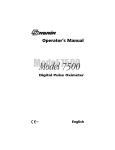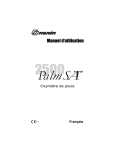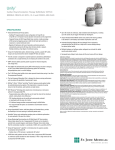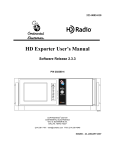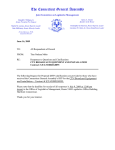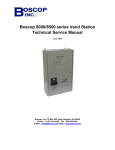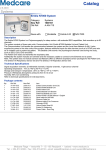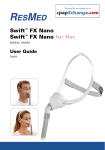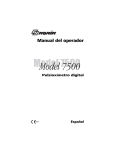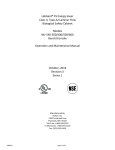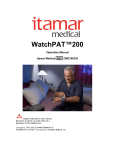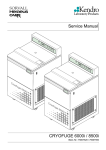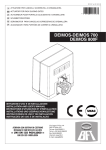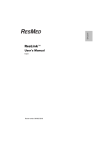Download Avant 2120
Transcript
Operator’s Manual Avant 2120 ™ Pulse Oximeter and NIBP Monitor 0123 1 English CAUTION! Federal law (USA) restricts this device to sale by or on the order of a physician. CAUTION! Read this entire manual carefully before using the Avant 2120 Pulse Oximeter and Noninvasive Blood Pressure Monitor. The information in this manual has been checked carefully and is believed to be accurate. In the interest of continued product development, NONIN reserves the right to make changes and improvements to this manual and the products it describes at any time, without notice or obligation. Nonin Medical, Inc. 2605 Fernbrook Lane North Plymouth, Minnesota 55447-4755 USA • (763) 553-9968 • (800) 356-8874 (USA and Canada) • Fax (763) 553-7807 • [email protected] • www.nonin.com References to “NONIN” in this manual shall imply Nonin Medical, Inc. Nonin is a registered trademark of Nonin Medical, Inc. © 2003 Nonin Medical, Inc. Table of Contents Guide to Symbols ........................................................ 1 Precautions for Use .................................................... 2 Using the Avant 2120 .................................................. 5 Indications for Use ......................................................... 5 Installing the Batteries .................................................... 6 Verifying Avant 2120 Operation .................................. 7 Avant 2120 Alarm Limit Power On Defaults ............ 7 Displays, Indicators, and Controls ............................... 8 Taking %SpO2 Measurements ...................................13 Taking Blood Pressure Measurements ......................13 Automatic and Demand NIBP Measurements ........16 Calibrating Blood Pressure on the Avant 2120 ........17 Advanced Features ........................................................18 Care and Maintenance ..................................................20 Alarms and Limits .....................................................21 Alarms .............................................................................21 Alarm Summary .............................................................23 Setting and Changing Volume and Alarm Limits ....24 Setting and Changing NIBP Settings .........................25 Communication ........................................................ 26 Memory Features ..........................................................26 Using the Avant 2120 with nVISION™ Software ..27 Real-Time Patient Data Output ..................................28 Specifications ............................................................ 29 Parts and Accessories ................................................31 Service, Support, and Warranty ................................ 33 Troubleshooting ....................................................... 35 Guide to Symbols Detailed information about functional symbols can be found in this manual’s “Using the Avant 2120” section. Symbol Description/Function Attention: See Instructions for Use or related materials. ! Type BF Applied Part: Defibrillator Proof (Patient isolation from electrical shock). Applies to NIBP. C SSIFIE LA UL D C Type BF Applied Part (Patient isolation from electrical shock). Applies to pulse oximeter. US 0123 SN UL Mark for Canada and the United States with respect to electric shock, fire, and mechanical hazards only in accordance with UL 2601-1 and CAN/CSA C22.1 No. 601.1. CE Marking indicating conformance to EC directive No. 93/42/EEC concerning medical devices. Serial Number (located under the battery cover). Signal Output 1 Precautions for Use Precautions for Use Read and follow all safety instructions in this chapter before using the Avant 2120. Contraindications Do not use the Avant 2120 in a magnetic resonance imaging (MRI) environment. Do not use the blood pressure module of the Avant 2120 on neonatal patients. Warnings The Avant 2120 is intended only as an adjunct in patient assessment. It must be used in conjunction with other methods of assessing clinical signs and symptoms. This equipment is intended for use in the presence of electrosurgery; however, its general operation might be affected by the use of an electrosurgical unit (ESU). As with all medical equipment, carefully route patient cables and connections to reduce the possibility of patient entanglement or strangulation. Use the Avant 2120 only within the specified temperature ranges: +32°F to +122°F (0°C to 50°C) for operating, and -22°F to 122°F (-30°C to +50°C) for storage and transportation. Do not use a damaged sensor or NIBP cuff under any circumstances. All parts and accessories connected to the serial port of the Avant 2120 must be certified according to IEC Standard EN 60950 or UL 1950 for data-processing equipment. Use the Avant 2120 with 300PS-XX, where XX represents the power supply designation. The Avant 2120 NIBP function has been designed for use on patients with normal sinus rhythms. Use only NONIN-manufactured pulse oximeter sensors. These sensors are manufactured to meet the accuracy specifications for NONIN pulse oximeters. Using other manufacturers’ sensors can result in improper pulse oximeter performance. Discontinue use of adhesive tape strips if the patient exhibits an allergic reaction to the adhesive material. Explosion Hazard: Do not use the Avant 2120 in an explosive atmosphere or in the presence of flammable anesthetics or gases. Do not stretch the adhesive tape while applying the pulse oximeter sensor. Applying the blood pressure cuff to the same arm used for a pulse oximeter might affect pulse oximeter readings. Use only NONIN-supplied blood pressure cuffs and hoses. Using other cuffs might result in inaccurate readings or inability to operate the Avant 2120. Do not compress or hold the blood pressure cuff or cuff hose while the Avant 2120 is operating. Do not apply the blood pressure cuff to an arm being used for intravenous infusion or to any area with restricted circulation. 2 Do not use the blood pressure cuff on neonates and patients known to be readily susceptible to bruising. Ensure that the blood pressure cuff is sized and placed correctly for each patient. Ensure that all Avant 2120 users know how to manually remove the blood pressure cuff in case it fails to deflate. The safety and effectiveness of the Avant 2120 NIBP function in pregnant women have not been established. Do not operate the Avant 2120 blood pressure module unless it has been properly calibrated. Inaccurate blood pressure readings can result if the Avant 2120 has not been calibrated properly. A calibration check is recommended at least once every year. Cautions Before using any sensor or NIBP cuff, carefully read the Directions for Use, which contain specific application times. Do not, under any circumstances, perform any testing or maintenance on the Avant 2120 while it is being used to monitor a patient. This equipment complies with International Standard EN 60601-1-2:1993 for electromagnetic compatibility for medical electrical equipment and/or systems. This standard is designed to provide reasonable protection against harmful interference in a typical medical installation. However, because of the proliferation of radio-frequency transmitting equipment and other sources of electrical noise in healthcare and other environments (for example, cellular phones, mobile two-way radios, electrical appliances), it is possible that high levels of such interference due to close proximity or strength of a source might disrupt the performance of this device. Verify that all visible indicators light during the start- up (initialization) sequence. If any indicator does not illuminate (except the AC Power Adapter LED), do not use the Avant 2120. Contact NONIN Customer Support for assistance. If the Avant 2120 fails to respond as described, discontinue use until the situation has been corrected by qualified personnel. Do not remove any covers other than the battery cover when replacing batteries. There are no user-serviceable parts inside—other than the replaceable batteries. Batteries might leak or explode if used or disposed of improperly. Follow local governing ordinances and recycling instructions regarding disposal or recycling of the device and device components, including batteries. Do not immerse the Avant 2120 or NONIN sensors in water or any other liquids, and do not place liquids on top of the Avant 2120. The Avant 2120 is a precision electronic instrument. It must be repaired by trained NONIN personnel only. 3 Precautions for Use The Avant 2120 is designed to determine the percentage of arterial oxygen saturation of functional hemoglobin. Significant levels of dysfunctional hemoglobin, such as methemoglobin, might affect the accuracy of the measurement. The Avant 2120 might misinterpret motion as good pulse quality (as indicated by a green pulse quality display). Minimize the patient’s finger motion as much as possible, or change the type of sensor being used (e.g., ear clip). Check the pulse oximeter sensor application site frequently to determine the positioning of the sensor and the circulation and skin sensitivity of the patient. Patient sensitivity to the Avant 2120 varies depending on medical status or skin condition. Do not use the 300PS-UNIV battery charger if the integrity of the protective earth conductor of the AC cord or the outlet is in doubt. Cardiogreen and other intravascular dyes, depending upon their concentrations, might affect the accuracy of the SpO2 measurement. Ear Clip and Reflectance sensors are not recommended for pediatric use. The accuracy of the sensors has not been established for pediatric use. Some nail polish colors or artificial nails can reduce light transmission and affect SpO2 accuracy. Check the NIBP cuff application site frequently to ensure that the cuff is not causing prolonged impairment of the patient’s circulation. The Avant 2120 might not work on all patients. Check to ensure that the proper cuff size is used. If you are unable to achieve stable readings, discontinue use. In certain circumstances, the normal application of a blood pressure cuff might exasperate an underlying medical condition. Be aware of potential circulatory disorders in all patients using the Avant 2120. Blood pressure recordings can be affected by the subject’s position, physiological condition, and other factors. When using the 300PS-UNIV battery charger, ensure that the AC cord is plugged into a grounded outlet. 4 Using the Avant 2120 This section describes how to use the Avant 2120. Indications for Use The NONIN® Avant 2120 Pulse Oximeter and NIBP Monitor is a portable device indicated for use in measuring and displaying functional oxygen saturation of arterial hemoglobin (SpO2), pulse rate, and blood pressure of adult and pediatric patients in hospitals, medical facilities, and subacute environments. The Avant 2120 is intended for spot-checking and/or continuous monitoring of patients. Its functions may be used separately or simultaneously. Pulse Oximeter Intended Use The pulse oximeter is intended for noninvasively monitoring the oxygen saturation and pulse rate of adult, pediatric, infant, and neonatal patients in hospitals, medical facilities, and subacute environments. It may be used for spot-checking and/or continuous monitoring of patients. Blood Pressure Monitor Intended Use The blood pressure monitor is intended for noninvasively monitoring the blood pressure of adult and pediatric patients in hospitals, medical facilities, and subacute environments. The blood pressure monitor is not intended for use with neonates. It is intended for attended care and may be used for spot-checking. The Avant 2120 should be used for patients with arm circumferences of 18-42 cm. MAP mmHg 5 Using the Avant 2120 Installing the Batteries 2120.003 NOTE: Reposition the back cover carefully, and tighten the screws firmly—being careful not to over-tighten. Contact NONIN to purchase or replace battery packs. NOTE: Removing power from the Avant 2120 erases all previous oximetry and NIBP data, but it does not erase any user-defined alarm limits. 6 Verifying Avant 2120 Operation Press the ON/STANDBY button. When the unit is first turned on, the Avant 2120 performs a brief startup (initialization) sequence. Verify that all LEDs illuminate and the unit beeps three times during the first phase of the startup sequence. If any LED is not lit (except the AC Power Adapter LED), do not use the Avant 2120. Contact NONIN Customer Support for assistance. In order to verify that the Avant 2120 is functioning properly, it is important to monitor SpO2 and pulse rate readings. Use the following procedure to verify that the pulse oximeter sensor is functioning properly. 1. 2. 3. Ensure that the Avant 2120 is on, with the sensor connected. Apply the pulse oximeter sensor. Verify that a good SpO2 reading is displayed, that a pulse rate value appears, and that the pulse strength bargraph LED is active. Avant 2120 Alarm Limit Power On Defaults The Avant 2120 provides the capability to define power on alarm limit defaults that are different than the factory settings. The two sets of defaults are selected using DIP switch 8 (DOWN = Factory, UP = User Defined). During initialization, FAC DFL or USR DFL will appear briefly in the SpO2 and Pulse Rate display areas to indicate which set of defaults are in use. After initialization, any of the alarm limits can be modified. To program user-defined power on alarm limit defaults, set DIP switch 8 to the UP position. A value for each limit must be programmed before the unit will continue to operate. To return to factory power on defaults, DIP switch 8 must be set in the DOWN position before entering power on initialization. NOTE: The unit must be using factory defaults before programming userdefined power on alarm limit defaults. 7 Using the Avant 2120 Displays, Indicators, and Controls This section describes the Avant 2120’s displays, indicators, and controls. Avant 2120 Parameter Displays %SpO2 Display Numeric light-emitting diodes (LEDs) on the upper left-hand corner of the Avant 2120 display blood oxygen saturation in percent. Pulse Rate Display The pulse rate display is the lower numeric display on the upper left-hand corner of the Avant 2120 (identified by the symbol). This 3-digit LED display shows the pulse rate in beats per minute. Systolic Pressure Display The systolic display is a 3-digit LED display near the upper right-hand corner of the Avant 2120. The Systolic number displayed represents the blood pressure in mmHg during contraction of the ventricles. Diastolic Pressure Display The diastolic display is a 3-digit LED display in the middle right-hand side of the Avant 2120. The Diastolic number displayed represents the blood pressure in mmHg when the ventricles are relaxed. MAP (Mean Arterial Pressure) Display The MAP display is a 3-digit LED display near the middle right-hand side of the Avant 2120. The MAP number displayed is a calculated value in mmHg, based on measurements of systolic and diastolic pressure: MAP = 2/3 diastolic + 1/3 systolic Numeric LEDs Numeric LEDs appear for SpO2, Pulse Rate, and blood pressure data, and for time and date displays, cuff pressure, volume, and NIBP history review. There are five 3-digit multicolor numeric LEDs on the Avant 2120. They are used for SpO2, pulse rate, and blood pressure displays. Under normal conditions, these LEDs are displayed in green. For high priority (patient) alarms, the values are displayed in red, blinking fast. For medium priority (equipment) alarms, the values are displayed in amber, blinking slowly. There is a four-digit, green, numeric LED on the Avant 2120 as well. It is used primarily to display date and time information, adjust volumes, adjust the auto NIBP cycle time, and set the initial NIBP cuff pressure. 8 Indicators and Icons Pulse Oximeter Sensor LED The Pulse Oximeter Sensor LED indicates when a sensor has become disconnected, has failed, or has not been applied correctly. Pulse Strength Bargraph LED This 10-segment multicolor bargraph indicates pulse strength as determined by the oximeter. The bargraph changes color based upon the strength of the pulse. The color and height of the Pulse Strength Bargraph is proportional to the pulse amplitude. For a low pulse amplitude, the unit goes into High Priority Alarm mode. Green = a good pulse strength Amber = a marginal pulse strength Red = a low pulse strength, high priority alarm The Pulse Strength Bargraph LED also indicates the battery charge percentage in 10% increments in green, displaying the depleted portion of the bargraph in amber. Pulse Quality LED This LED blinks to indicate a poor pulse quality. If there is a sustained series of poor pulses, the Pulse LED will illuminate solid. Pulse Volume LED This amber LED indicates that the unit is in Pulse Volume Program mode. When this LED is lit, pulse volume can be adjusted using the Plus (+) and Minus (-) buttons on the front panel. The highest volume is 15, and the lowest volume is 0. The default volume level is 4. The Avant 2120 beeps while pulse volume is being changed, showing the volume progression as it is adjusted. Auto NIBP Mode LED This multicolor LED indicates that the unit is in Auto NIBP mode when it is lit green. When lit amber, this LED indicates that the unit is in Auto NIBP Cycle Time Program mode. The cycle time can be adjusted using the Plus (+) and Minus (-) buttons. Keypad Round LED Indicators mmHg Keypad round LED indicators display whether or not the Avant 2120 is functioning in certain modes (NIBP History Display mode or Initial Cuff Pressure Display/Modify mode). 9 Using the Avant 2120 Battery LED This amber LED indicates a marginal battery capacity by blinking in sync with the Main Alarm LED indicator. In addition, this LED— when lit solid—indicates that the battery capacity is being displayed. This LED does not indicate that the Avant 2120 is running on battery power. AC Power Adapter LED This green LED is displayed when an external power supply is providing power to the Avant 2120. Alarm Silence LED This amber LED indicates that the audible alarm is temporarily silenced when it blinks. When lit solid, the Alarm Silence LED indicates that the audible alarm volume is set to zero. Main Alarm LED The Main Alarm LED indicates visible alarm conditions. It indicates high priority (via red color blinking fast) or medium priority (via amber color blinking slowly) alarm conditions. Alarm Volume LED This amber LED indicates that the unit is in Alarm Volume Program mode. When this button is illuminated, the alarm volume can be adjusted by using the Plus (+) and Minus (-) buttons on the front panel. The highest volume is 15, and lowest volume is 8. The default volume level is 8. If DIP switch 2 is moved to the UP position, then the alarm volume can be adjusted to zero. Time, Month, Day, and Year LEDs These amber LEDs indicate that the Avant 2120’s Time, Month, Day, or Year displays can be reviewed or adjusted using the Plus (+) and Minus (-) buttons. 10 Avant 2120 Keyboard Buttons NIBP Button This button is used to begin or cancel a single blood pressure measurement. While the unit is taking a blood pressure reading, pressing any button on the front panel will cancel the action and deflate the cuff. Auto NIBP Cycle Time Button This button is used to display the automatic blood pressure measurement cycle time. The Plus (+) and Minus (-) buttons are used to change the cycle time setting. The unit can be set to start a blood pressure reading every 1, 2, 3, 5, 10, 15, 30, 45, 60, or 90 minutes after the previous blood pressure reading is complete. The NIBP timer begins after the previous blood pressure measurement is completed. NIBP History Review Button This button displays previously measured blood pressure values. The Plus (+) and Minus (-) buttons can be used to scroll through and display stored NIBP readings. All previous blood pressure values— including those from previous recording sessions—can be reviewed. Up to 300 readings can be reviewed using the NIBP History Review button. No readings are lost when the unit is put into Standby mode; however, only the most recent 300 readings can be retrieved. Readings from previous sessions are indicated with a blinking time stamp. Initial Cuff Pressure Button mmHg This button displays the initial cuff inflation pressure, i.e., the amount of pressure to which the cuff initially inflates to begin to obtain a reading. The inflation pressure will readjust, based on the patient’s previous blood pressure. The initial cuff pressure can be changed using the Plus (+) and Minus (-) buttons. Initial cuff pressure can be set to 120, 140, 160, 180, 200, 220, or 240 mmHg. ON/STANDBY Button This button toggles the Avant 2120 between ON and STANDBY modes. Pressing this button once turns on the Avant 2120. Pressing and holding this button for at least 1 second turns off the Avant 2120. Briefly pressing this button while the unit is on displays the battery capacity percentage, in 10% increments, for four seconds in green. It displays the remainder of the bargraph in amber. If the ON/ STANDBY button is pressed again, the battery capacity display exits. Otherwise, the battery capacity display will exit after four seconds. 11 Using the Avant 2120 Alarm Silence Button This button toggles the alarm between silenced and audible. Pressing the Alarm Silence button silences all alarms for two minutes. In addition, pressing and holding this button for two seconds clears all NIBP high and medium priority alarms (including any displayed NIBP data). Limits Button This button displays the upper and lower limits for alarm indications for SpO2, heart rate, systolic, diastolic, and MAP measurements. These limits can be adjusted using the Plus (+) and Minus (-) buttons. The upper LED on the Limits button indicates that the upper alarm limit is being displayed, and the lower LED indicates that the lower alarm limit is being displayed. The limit values are displayed in amber within the appropriate 3-digit numeric display. (For example, the limits for %SpO2 are displayed within the %SpO2 numeric display.) Plus and Minus Buttons These buttons adjust values for many Avant 2120 functions. The Plus and Minus buttons are used to adjust timing of automatic blood pressure readings, initial cuff pressure, time, date, volume, and upper and lower alarm limits. These buttons are also used to scroll through the NIBP history. Pressing this button alone, when the Avant 2120 is not in any program mode, adjusts the intensity of the LED displays. Time/Date Button This button displays the time and date. In US mode, pressing the button toggles the user through the year, month, day, hour, and minute, which can be set using the Plus (+) and Minus (-) buttons. Placing DIP switch 3 in the UP position allows users to view and set the time and date in International mode. Volume Button This button displays the pulse volume and alarm volume, depending upon which corresponding LED is illuminated. The pulse and alarm volumes can be adjusted using the Plus (+) and Minus (-) buttons. 12 Taking %SpO2 Measurements The 2120’s NIBP and %SpO2 functions can be used separately or simultaneously. To take %SpO2 measurements with the 2120, ensure that the unit is on with the sensor connected. Apply the sensor, following the instructions on the respective sensor instructional insert. SpO2 and pulse rate measurements will be displayed in the %SpO2 and Pulse Rate display areas. Taking Blood Pressure Measurements This section describes how to take blood pressure readings with the Avant 2120. NOTE: If an accurate NIBP reading cannot be achieved, the Avant 2120’s cuff will begin to reinflate, attempting a second blood pressure measurement. If the cuff does not automatically reinflate, restart the blood pressure reading, and/or adjust the cuff position as necessary. The device will time out two minutes after a reading cannot be determined. Inaccurate NIBP measurements can result from many sources, but users can take precautions to ensure that the Avant 2120 operates efficiently. Blood pressure readings might be compromised if patient motion is excessive, if an inappropriate cuff size is being used, if the cuff is positioned improperly, or if the patient has a restricted blood flow. If inaccurate blood pressure measurements are suspected, ensure that the arm cuff is positioned properly and that the Avant 2120 has been properly calibrated. NIBP Cuff Selection In order to guarantee accurate readings, the appropriate cuff size must be selected for each patient. CAUTION! Use only Nonin-supplied blood pressure cuffs and hoses with the Avant 2120. Using other cuffs might result in inaccurate readings or inability to operate the Avant 2120. Small Adult BP Cuff 18-26 cm arm circumference Standard Adult BP Cuff 26-35 cm arm circumference Large Adult BP Cuff 32-42 cm arm circumference 13 Using the Avant 2120 NIBP Cuff Placement Cuffs can be carefully placed on either the right or left arm. Apply the cuff around the bicep slightly above the elbow, so that the inflation bladder is centered over the brachial artery (the inflation bladder is approximately half of the entire length of the cuff). Do not apply the blood pressure cuff to an arm encumbered with an IV. The patient’s arm should be resting comfortably, preferably at a level that is parallel to his or her heart, with the arm adjusted so that the palm is positioned upward. If a comfortable fit is difficult to achieve, a different cuff size might be required. Refer to the circumference size in centimeters, which is printed on the cuff label. Blood pressure arm cuffs should be applied directly to the patient’s skin. Applying cuffs over shirt sleeves or other materials could affect the accuracy of blood pressure readings. Patients should maintain a relaxed position with feet flat on the floor (if sitting). Opposite limbs should be used for the blood pressure arm cuff and the finger clip sensor. WARNING! In order to achieve accurate results—and for important safety reasons—the blood pressure cuff must only be placed on the patient’s arm. Proper Cuff Placement. 14 Use the following procedure to take blood pressure measurements with the Avant 2120. NOTE: The NIBP unit can be used without the oximeter. If the unit is turned on without an oximeter sensor, the oximeter will be disabled and the SpO2 display will remain blank. Plugging in the oximeter sensor at any time will enable the oximeter. 1. Ensure that the Avant 2120 is on and functioning properly. 2. Connect the blood pressure arm cuff and pulse oximeter sensor to the Avant 2120. • To plug in the blood pressure arm cuff, insert the cuff ’s hose connector just above the %SpO2 connector on the left side of the unit. • To plug in the pulse oximeter sensor, insert the connector in the %SpO2 connector on the left side of the unit, with the NONIN logo facing up. %Sp0 2 Connecting the finger clip sensor. 15 Using the Avant 2120 3. Carefully place the blood pressure arm cuff around the patient’s bicep. NOTE: Blood pressure cuffs can be placed on either the right or left arm, but accurate readings depend upon using opposite limbs for the finger clip sensor and blood pressure cuff. 4. Place the finger clip sensor on the patient’s finger. While the sensor is in place, do not press it against any surface and do not squeeze or hold it together. The correct amount of pressure will automatically be applied. Additional pressure might cause incorrect readings. 5. When the patient is ready, press the NIBP button to begin a single blood pressure measurement. The arm cuff will begin inflating, and the cuff pressure value will appear in the Time LED area on the front panel display. 6. Wait for the reading to be completed. When the reading is complete, the Systolic, Diastolic, and MAP numeric LEDs will illuminate—providing the results for blood pressure. If there is no pulse rate value measured from the oximeter sensor, the pulse rate value from the NIBP will illuminate. NOTE: If the finger clip sensor is not worn while blood pressure is measured, the Avant 2120 will display heart rate information as measured from the blood pressure arm cuff; however, no %SpO2 data will be displayed. When the finger clip sensor is worn, the %SpO2 and heart rate data are displayed based upon readings only from the finger clip sensor—not the blood pressure reading. NOTE: If a blood pressure reading must be cancelled for any reason, simply press any button on the front panel—except the Alarm Silence button—to stop the reading and deflate the cuff. Pressing the Alarm Silence button will not cancel blood pressure readings. Automatic and Demand NIBP Measurements The Auto NIBP Cycle Time button is used to begin or end timed blood pressure measurements and display the Auto NIBP Cycle time, which can be adjusted using the Plus (+) and Minus (-) buttons. Blood pressure readings can be started every 1, 2, 3, 5, 10, 15, 30, 45, 60, or 90 minutes after the previous reading. The NIBP timer begins after the previous blood pressure measurement is completed. Automatic NIBP measurements are useful in many circumstances. They are especially appropriate when continuous spot-checking of patients is desired or to determine fluctuations in blood pressure over periods of time. Demand NIBP measurements are single-time measurements taken by pressing the NIBP button on the Avant 2120. They are useful for individual readings and when long-term spot-checking is unnecessary. 16 Calibrating Blood Pressure on the Avant 2120 Use the following procedure to calibrate blood pressure on the Avant 2120. Calibration should be performed after every 10,000 inflations or once per year. Calibration should only be performed by qualified personnel. Suggested Equipment: • Mercury Manometer • Pneumatic T-Adapter • Pressure Bulb 1. With the unit turned off, connect a mercury manometer and pressure bulb to the Avant 2120 using a T-adapter. 2. Using the tip of a screwdriver or other similar device, place DIP switch 1 in the UP position. 3. Turn on the Avant 2120. A CAL message is displayed in the Systolic display window, acknowledging that the Avant 2120 is in Calibration mode. 4. Wait for a green “0” to appear in the Diastolic LED display window. 5. Ensure that the pressure on the manometer is zero. This will ensure that there is no pressure difference at the pressure transducer and outside the unit. 6. Press the NIBP button. A countdown will begin, followed by “250” in the Diastolic display. This “250” prompt indicates the pressure required from the manometer. 7. Using the pressure bulb, apply exactly 250 mmHg to the Avant 2120. 8. Press the NIBP button to calibrate the device at 250 mmHg. The Avant 2120 is now calibrated and will display a cal dne message. 9. Press the ON/STANDBY button to power down the Avant 2120. 10. Return DIP switch 1 to the DOWN position. NOTE: The pulse oximeter does not require calibration. 17 Using the Avant 2120 Advanced Features This section describes the advanced features available on the Avant 2120. Key Combinations The Avant 2120 provides two advanced features that are available by using multiple key combinations. The unit must be in Standby mode before using either of the advanced features. Button Combination + + Feature Name Function Retain Previous UserDefined Alarm Limits This feature allows users to retain the previously set userdefined alarm limits—even after shutting down the Avant 2120. To use this feature, hold the Limits button while pressing the ON/STANDBY button to power the unit. Clear Oximeter Memory This feature allows users to clear the oximeter memory. To use this feature, hold the NIBP History Review button while pressing the ON/STANDBY button to power the unit. NOTE: If the Limits button and NIBP History Review button are both held while pressing the ON/STANDBY button to power the unit, both of the above advanced features are invoked. 18 Avant 2120 DIP Switches The Avant 2120 contains eight DIP switches. The UP position is toward the top of the unit, and the DOWN position is toward the bottom of the unit. The DIP switches are located under the green battery cover on the rear of the unit. A small Phillips screwdriver must be used to remove the battery cover. The default for all Avant 2120 DIP switches is the DOWN position. Switch Function Switch 1 Up—Calibration Mode Down—Normal Operation (Default) Switch 2 Alarm Disable/Minimum Alarm Volume Definition: See “Silencing Alarms” for more information. Up—0 dB Down—45 dB (Default) Switch 3 Up—International Date Format Down—USA Date Format (Default) Switch 8 Up—User-Defined Power On Alarm Limit Defaults Down—Factory Power On Alarm Limit Defaults (Default) CAUTION! Do not place DIP switch 1 in the UP position unless unit calibration is intended. 1 2 3 4 5 6 7 8 Avant 2120 DIP Switches. 19 Using the Avant 2120 Care and Maintenance The advanced digital circuitry within the pulse oximeter of the Avant 2120 requires no calibration or periodic maintenance other than battery replacement. The NIBP module requires calibration after every 10,000 inflations or once each year. Field repair of the Avant 2120 circuitry is not possible. Do not attempt to open the Avant 2120 case or repair the electronics. Opening the case will damage the Avant 2120 and void the warranty. If the Avant 2120 is not functioning properly, see “Troubleshooting.” Cleaning the Avant 2120 Clean the Avant 2120 separately from its associated sensors. For instructions regarding cleaning pulse oximeter sensors, refer to the appropriate pulse oximeter sensor package inserts. Clean the Avant 2120 with a soft cloth dampened with isopropyl alcohol. Do not pour or spray any liquids onto the Avant 2120, and do not allow any liquid to enter any openings in the device. Allow the Avant 2120 to dry thoroughly before reuse. Cleaning the Blood Pressure Arm Cuff To clean the blood pressure arm cuff, simply wipe the cuff with a soft cloth dampened with isopropyl alcohol. Do not pour or spray any liquids onto the arm cuff, and allow the cuff to dry thoroughly before reusing it. 20 Alarms and Limits This chapter describes the alarms, limits, and error codes for the Avant 2120. Alarms The Avant 2120 provides a variety of audible and visual alarms, which are either high or medium priority. It also provides informational tones. High Priority Alarms High priority alarms are those that require immediate attention to the patient. On the Avant 2120, high priority alarms are indicated with rapidly blinking red LED displays when alarm limits are met or exceeded. In addition, the pulse strength bargraph LED may illuminate a red segment to indicate low perfusion. High priority alarms are sounded as follows: “beep, beep, beep,” (short pause), “beep, beep” (10-second pause). Medium Priority Alarms Medium priority alarms are those that signal potential problems with the equipment or other non-life-threatening situations. On the Avant 2120, medium priority alarms are indicated with slowly blinking amber displays. Medium priority alarms are illuminated amber on the Main Alarm LED and on the appropriate indicator(s) or numeric displays, sometimes displaying an error code to help the user identify the source of the error. Use the “Error Codes” table to identify error codes that might appear on the Avant 2120 front panel. All error codes are displayed in the MAP display area. Medium priority alarms are sounded as follows: “beep, beep, beep,” (25-second pause), “beep, beep, beep.” Informational Tones Informational tones communicate important information. They are typically single “beeps” or a series of three “beeps.” Informational tones include the startup/ initialization tone and the pulse rate tone (which changes in pitch with SpO2 values). Watchdog Alarm Watchdog alarms are loud, two-tone, steadily beeping signals that indicate a hardware or software malfunction. When a watchdog alarm is activated, it can be cleared by shutting down the Avant 2120 (press and hold the ON/STANDBY button for one second). If the watchdog alarm cannot be cleared, contact NONIN Customer Support. 21 Alarms and Limits Error Codes The Avant 2120 includes various error codes to indicate potential problems with the unit. The following table describes the error codes present on the Avant 2120. Error Codes CAN E00 E01 E02 E03 E04 E05 E06 E07 E10 E11 E13 E17 E19 E31 E32 E33 E34 E35 E36 E37 22 NIBP Module, User Cancelled: NIBP module was cancelled from taking blood pressure reading. System Error: Retry reading. If reading is not possible, then cycle power and retry. Calibration may be required. Call NONIN Customer Support if error persists. NIBP Module, Bad Signals: NIBP module cannot complete reading. Failure could be due to patient’s blood pressure falling outside module’s range. Check patient, air hose connection, and cuff application. NIBP Module, Overpressure: Overpressure condition occurred. NIBP Module, Air Leak: Check hose and cuff for damage or air leaks. NIBP Module, Blockage in Line: Check hose for kinks or blockage. Check NIBP module for any obstructing materials. NIBP Module, Safety Timer Timeout: Allowed time expired before reading was complete, or system remained in test mode for more than three minutes. NIBP Module, Gross Movement: Check patient, reduce motion. NIBP Module, Transducer Out of Range: Zero calibration drifted beyond range of automatic zero circuit. Module pressure transducer may need recalibration. NIBP Module, Calibration Data Invalid NIBP Module, ADC Hardware Failure NIBP Module, Pressure Calibration Failed: Module unable to reset pressure calibration data. Undefined NIBP Error NIBP Module, No Communication: No data from NIBP module. Sound Error: Channel 1 Failure Sound Error: Channel 2 Failure Sound Error: Both Channels Failure Sound Error: Amplifier Failure Sound Error: Channel 1 Failure, Amplifier Failure Sound Error: Channel 2 Failure, Amplifier Failure Sound Error: Channel 1 Failure, Channel 2 Failure, Amplifier Failure Error Codes E38 E39 E40 E41 E42 E43 E44 E45 E51 E52 E53 Sound Error: Speaker Failure Sound Error: Channel 1 Failure, Speaker Failure Sound Error: Speaker Failure, Channel 2 Failure Sound Error: Channel 1 Failure, Channel 2 Failure, Speaker Failure Sound Error: Speaker Failure, Amplifier Failure Sound Error: Channel 1 Failure, Speaker Failure, Amplifier Failure Sound Error: Speaker Failure, Channel 2 Failure, Amplifier Failure Sound Error: Channel 1 Failure, Channel 2 Failure, Speaker Failure, Amplifier Failure Sound Module, Communication Failure: No SPI communication from sound module to display board microcontroller. SCI Communication Error: SCI communication problem. Too many overrun, checksum, and/or sync errors. External Memory Failure: External (patient data) memory failed test. Alarm Summary If patient readings are equal to or above the upper alarm limit, or if they are equal to or below the lower alarm limit, the Avant 2120 will signal a high priority alarm. Alarm Description Adjustment Range Default SpO2 Upper Alarm Limit Off, 80 to 100 by 1% Off SpO2 Lower Alarm Limit Off, 50 to 95 by 1% 80% Pulse Upper Alarm Limit Off, 75 to 275 by 5 BPM 200 BPM Pulse Lower Alarm Limit Off, 30 to 110 by 5 BPM 50 BPM Systolic Upper Alarm Limit Off, 75 to 240 by 5 mmHg 200 mmHg Systolic Lower Alarm Limit Off, 50 to 150 by 5 mmHg 60 mmHg Diastolic Upper Alarm Limit Off, 50 to 180 by 5 mmHg 120 mmHg Diastolic Lower Alarm Limit Off, 25 to 125 by 5 mmHg 30 mmHg MAP Upper Alarm Limit Off, 70 to 200 by 5 mmHg 150 mmHg MAP Lower Alarm Limit Off, 25 to 125 by 5 mmHg 50 mmHg 23 Alarms and Limits Setting and Changing Volume and Alarm Limits IMPORTANT! The Avant 2120 alarm limits automatically reset themselves to default values each time the unit is powered up. To retain previously adjusted alarm limits, hold the Limits button while powering up the Avant 2120. Setting or Changing SpO2 and or Pulse Alarm Limits Use the following procedure to set or change the SpO2 or pulse alarm limits. 1. Ensure that the Avant 2120 is on and functioning properly. 2. Press the Limits button. The upper amber LED is illuminated on the Limits button, and OFF (if the default value) is displayed in the %SpO2 display. 3. Use the Plus (+) and Minus (-) buttons to adjust the upper SpO2 limit to the desired value. 4. When the desired upper alarm limit is displayed, press the Limits button to set the next alarm limit (SpO2 Lower Alarm Limit), or press the Limits button 10 times to exit the Set/Change Alarm Limits mode. (The Set/Change Alarm Limits mode exits automatically after ten seconds with no activity.) Setting or Changing Systolic, Diastolic, and MAP Alarm Limits Use the following procedure to set or change the systolic, diastolic, or MAP alarm limits. 1. Ensure that the Avant 2120 is on and functioning properly. 2. Press the Limits button five times. The upper amber LED is illuminated on the Limits button, and 200 (if the default value) is displayed in the Systolic display. 3. Use the Plus (+) and Minus (-) buttons to adjust the systolic upper alarm limit to the desired value. 4. When the desired upper alarm limit is displayed, press the Limits button to set the next alarm limit (Systolic Lower Alarm Limit), or press the Limits button six times to exit the Set/Change Alarm Limits mode. (The Set/Change Alarm Limits mode exits automatically after ten seconds with no activity.) Setting or Changing Alarm and Pulse Volumes Use the following procedure to set or change the alarm or pulse volumes. 1. Ensure that the Avant 2120 is on and functioning properly. 2. Press the Volume button. The Alarm Volume LED illuminates and 08 (if the default value) appears on the display screen. 3. Use the Plus (+) and Minus (-) buttons to adjust the alarm volume to the desired level. (The Alarm Volume ranges from 08-15.) 4. When the desired alarm volume is displayed, either press the Volume button once to set the next variable (Pulse Volume), press the Volume button twice to exit Set/ Change Alarm Volume mode, or simply wait 10 seconds to automatically exit Set/ Change Alarm Volume mode. 24 Silencing Alarms To silence alarms for two minutes, press the Alarm Silence button. In order to permanently silence all alarms, DIP switch 2 must be placed in the UP position. This allows the Alarm Volume to be set to zero. The Alarm Silence LED will remain illuminated when the alarm volume is set to zero. Setting and Changing NIBP Settings This section describes how to set and change NIBP settings on the Avant 2120. Setting or Changing Automatic NIBP Cycle Time Use the following procedure to set or change the automatic NIBP cycle time. 1. Ensure that the Avant 2120 is on and functioning properly. 2. Press the Automatic NIBP Cycle Time button. The Auto NIBP LED illuminates and OFF (if the default value) appears on the display screen. 3. Use the Plus (+) and Minus (-) buttons to adjust the automatic NIBP cycle time to the desired interval in minutes. 4. When the desired cycle time is displayed, either press the Automatic NIBP Cycle Time button once to exit NIBP Cycle Time mode, or simply wait 10 seconds to automatically exit NIBP Cycle Time mode. Setting or Changing Initial NIBP Cuff Inflation Pressure Use the following procedure to set or change the initial NIBP cuff inflation pressure. 1. Ensure that the Avant 2120 is on and functioning properly. 2. Press the Initial Cuff Pressure button. The default cuff pressure (typically 160) appears as an LED display. 3. Press the Plus (+) and Minus (-) buttons to adjust the initial NIBP cuff inflation pressure to the desired level. Users may select initial pressures of 120, 140, 160, 180, 200, 220, or 240. 4. When the desired inflation pressure is displayed, either press the Initial Cuff Pressure button once to exit NIBP Cycle Time mode, or simply wait 10 seconds to automatically exit NIBP Cuff Inflation Pressure mode. 25 Communication Communication Memory Features The Avant 2120 can collect and store up to 33.5 hours of SpO2 and pulse rate information. Data may be played back with data retrieval software (NONIN’s nVISION™ software is recommended). If you wish to create your own software, contact NONIN for the data format. NOTE: Only SpO2 and pulse rate data are available for data retrieval. The memory in the Avant 2120 functions much like an “endless loop” tape. When the memory fills up, the unit begins overwriting the oldest data with the new data. Each time the Avant 2120 is turned on, the current time/date information (if the clock is set properly) is stored in memory, starting a new recording session. Only recording sessions greater than one minute in length are stored in memory. Patient SpO2 and pulse rate are sampled every 2 seconds. Every 4 seconds, the extreme value of the 4-second sample period is stored. Oxygen saturation values are stored in 1% increments in the range of 0 to 100%. The stored pulse rate ranges from 18 to 300 pulses per minute. The stored values are in increments of one pulse per minute in the interval from 18 to 200 pulses per minute, and in increments of 2 pulses per minute in the interval from 201 to 300 pulses per minute. 26 Using the Avant 2120 with nVISION™ Software The Avant 2120 has a Memory Playback feature, allowing stored data to be transferred to NONIN’s nVISION™ software for analysis. Use the following procedure to use the Avant 2120 with nVISION™ software. 1. 2. 3. 4. 5. 6. 7. With the unit off, connect the RS-232 connector port of the Avant 2120 to the back of your computer using a null modem cable. With the Avant 2120 still off, press and hold the NIBP History Review button while pressing the ON/STANDBY button. All LEDs will illuminate briefly. “PLy” will appear in the SpO2 LED display area, and “bAC” will appear in the Systolic display area. This message signals that the Avant 2120 is now in Playback mode. The “PLy bAC” message will disappear after a few seconds, signalling that the memory playback is complete. Larger files might take several minutes before memory playback is complete. Pressing the ON/STANDBY button will exit Playback mode. A “CLr no” message will be displayed, and three informational tones will sound. • Use the Plus (+) and/or Minus (-) buttons to toggle between “YES” and “no” on the Systolic display window. Press the ON/STANDBY button when the desired Memory Clear selection is made. • If selecting “no,” pressing the ON/STANDBY button exits Playback mode, and normal Avant 2120 operation continues. • If selecting “YES,” pressing the ON/STANDBY button displays a “dEL” message in the %SpO2 display window and a “no” message in the Systolic display window. Use the Plus (+) and/or Minus (-) buttons to toggle between “YES” and “no” on the Systolic display window. CAUTION: Selecting YES from the “dEL” window will permanently delete the Avant 2120’s memory. If YES is selected, a “dnE CLr” message appears when patient data is clear. Press the ON/STANDBY button to return to normal operation. Follow the instructions in nVision™ to capture and analyze the data. NOTE: Patient oximetry and NIBP data are cleared simultaneously in Playback mode. 27 Communication Real-Time Patient Data Output The Avant 2120 provides real-time data output capability via the RS232 connector port. A null modem cable must be connected from the Avant 2120 to the receiving computer. RS232 Connector Port The information from the Avant 2120 in the real-time mode is sent in an ASCII serial format at 9600 baud with 9 data bits, 1 start bit, and 1 stop bit. The data are output at a rate of once per second (on separate lines). Real-time data may be printed or displayed by devices other than the pulse oximeter. Upon power up, a header is sent identifying the format and the time and date. Thereafter, the data are sent once per second by the Avant 2120 in the following format: SPO2=XXX HR=YYY When NIBP data are displayed, the following format will appear: SPO2=XXX HR=YYY SYS=SSS DIA=DDD MAP=MMM where XXX is the SpO2 value, YYY is the heart rate value, SSS is the systolic value, DDD is the diastolic value, and MMM is the MAP value. Essentially, whenever NIBP data are available from the Avant 2120, that data will be displayed. If there are no data from the oximeter, the formats will appear as follows: SPO2=--- HR=--SPO2=--- HR=YYY SYS=SSS DIA=DDD MAP=MMM The Avant 2120 includes an event marker feature. Events are indicated by a single “*” whenever ON/STANDBY is pressed to go into Battery Capacity Display mode. (ON/STANDBY may be pressed again to exit, or Battery Capacity Display mode will time out after approximately 10 seconds.) This feature can be used to mark exceeded alarm limits, or in other situations as desired. SPO2=XXX HR=YYY* SPO2=XXX HR=YYY SYS=SSS DIA=DDD MAP=MMM* 28 Specifications OXIMETER Oxygen Saturation Range (%SpO2) 0% to 100% Pulse Rate Range 18 to 300 pulses per minute Displays Numeric Displays 3-digit LEDs, Tricolor (red, green, amber) Pulse Indicator Amber LED Accuracy Blood Oxygen Saturation 70% to 100% ± 2 digits (%SpO2) (± 1 S.D.)a Pulse Rate ± 3% Measurement Wavelengths and Output Power Red 660 nanometers @ 3 mw nominal Infrared 910 nanometers @ 3 mw nominal Altitude Operating Altitude Up to 40,000 feet Hyperbaric Pressure Up to 4 atmospheres NIBP Method of Measurement Oscillometric Blood Pressure Range Systolic: 40 mmHg to 260 mmHg Diastolic: 25 mmHg to 200 mmHg MAP = 1/3 Systolic + 2/3 Diastolic Pressure Transducer Accuracy ±3 mmHg between 0 mmHg and 300 mmHg for operating conditions between 0°C and 50°C. (S.D. of 8 mmHg) Recommended Frequency of Pressure Transducer Calibration The Pressure Transducer calibration should be verified yearly or every 10,000 readings, whichever comes first. Pulse Rate Range (displayed if there is no value from the oximeter) to 200 pulses per minute Blood Pressure Altitude -170 to 1700 m 29 Specifications SYSTEM Temperature Operating +32° to +122°F (+0° to +50°C) Storage/Transportation -22° to +122°F (-30° to +50°C) Humidity Operating 10% to 90% noncondensing Storage/Transportation 10% to 95% noncondensing Power Requirements Mains 100-240 VAC 50-60 Hz DC Input 12 VDC 1.5A AC adapter Internal Power Battery 7.2 volt battery pack (6 cells) Operating Life minimum 5 hours of continuous operation Storage Life 18 days Recharge Time 4 hours with unit off Dimensions 11.4 x 19.0 x 13.8 cm Weight 45.3 oz with batteries Classifications per IEC 60601- 1 / CSA601.1 / UL2601-1 Type of Protection Class I (when on AC power with 300PS-UNIV battery charger) Class II (when on AC power with 300PS-NA, 300PS-EU, or 300PS-UK battery chargers) Internally powered (on battery power) a. 30 Degree of Protection Type BF-Applied Part (pulse oximeter and NIBP) Defibrillator Proof (NIBP only) Enclosure Degree of Ingress Protection IPX0 Mode of Operation Continuous S.D. (Standard Deviation) is a statistical measure; up to 32% of the readings may fall outside these limits. Parts and Accessories Model Number Description 2120B 2120 Manual Simple Cuff—Small Simple Cuff—Standard Simple Cuff—Large Connect-2 UNI-RA-1 UNI-RA-3 UNI-RA-0 300PS-NA 300PS-EU 300PS-UK 300PS-UNIV Battery Pack Operator’s Manual for the Avant 2120 Small NIBP Cuff Standard NIBP Cuff Large NIBP Cuff Tubing 40” 90-degree patient cable 120” 90-degree patient cable 7.25” 90-degree patient cable Battery Charger, North American/Japan: Wall Mount Battery Charger, Europe: Wall Mount Battery Charger, United Kingdom: Wall Mount Battery Charger, Universal Desktop With Iec320 Connector Contact your distributor or NONIN Cord Set, Charger for options. 2120 Pole Mount UNI-RS232 8000AA-1 8000AA-3 8000K2 8000AP-1 8000AP-3 8000J 8008J 8001J 8000Q 8000R Pole Mount RS-232 Cable . Pulse Oximeter Reusable Sensors Adult Articulated Finger Clip Sensor (1 meter) Adult Articulated Finger Clip Sensor (3 meters) Adult Finger Clip Sensor Pediatric Finger Clip Sensor (1 meter) Pediatric Finger Clip Sensor (3 meters) Adult Flex Sensor Infant Flex Sensor Neonatal Flex Sensor Ear Clip Sensor Reflectance Sensor 31 Parts and Accessories Model Number Description 7000A 7000P 7000I 7000N 7000D Pulse Oximeter Disposable Sensors Adult Finger Flexi-Form II® Sensor, 10 per box Pediatric Finger Flexi-Form II® Sensor, 10 per box Infant Toe Flexi-Form II® Sensor, 10 per box Neonatal Foot Flexi-Form II® Sensor, 10 per box Flexi-Form II® Sensor Assortment Pack, 10 per box nVISION 8000JFW 8008JFW 8001JFW 8000H 8000T 8500I 8000S 9440 1000MC 1000RTC Other Accessories nVISION™ software for Microsoft Windows 95/98/ 2000/NT 4.0 operating systems Adult FlexiWrap Sensor Wrap Infant FlexiWrap Sensor Wrap Neonatal FlexiWrap Sensor Wrap Reflectance Sensor Holder System Sensor Attachment Tape, 100 per box Patient Extension Cable (1 meter) Patient Simulator Finger Phantom® Pulse Oximeter Tester Memory Cable (for use between the Avant 2120 and a PC running Microsoft Windows 95/98 operating systems) Real-Time and Memory Cable (for use between the Avant 2120 and a PC running Microsoft Windows 95/98 operating systems) For more information about NONIN parts and accessories, contact your distributor, or contact NONIN at (800) 356-8874 (USA and Canada) or (763) 553-9968. 32 Service, Support, and Warranty IMPORTANT! The Avant 2120 is a precision electronic instrument and must be repaired by trained NONIN personnel only. The Avant 2120 Pulse Oximeter module performs all computations from internal software stored in microprocessor chips. Thus, there are no critical parts to drift, and no calibration of the pulse oximeter module is required. The Avant 2120 NIBP module should be calibrated after every 10,000 checks or once per year, whichever comes first. For information about the Avant 2120 and accessories, contact your local sales representative or distributor. For the sales representative or distributor in your area, contact NONIN at (800) 356-8874. A return authorization number is required before returning any product to NONIN. To obtain this return authorization number, contact NONIN’s Customer Support Department at: Nonin Medical, Inc. 2605 Fernbrook Lane North Plymouth, Minnesota 55447-4755 USA • (800) 356-8874 (USA and Canada) • (763) 553-9968 (outside USA and Canada) • Fax (763) 553-7807 • [email protected] • www.nonin.com 33 Service, Support, & Warranty Warranty NONIN MEDICAL, INCORPORATED (NONIN) warrants to the purchaser, for a period of one year from the date of purchase, each Avant 2120 battery pack, and for two years from the date of purchase each blood pressure module. NONIN warrants the pulse oximetry module of the Avant 2120 for a period of three years from the date of purchase, and the blood pressure cuff for a period of 90 days from the date of purchase. NONIN shall repair or replace any Avant 2120 found to be defective in accordance with this warranty, free of charge, for which NONIN has been notified by the purchaser by serial number that there is a defect, provided said notification occurs within the applicable warranty period. This warranty shall be the sole and exclusive remedy by the purchaser hereunder for any Avant 2120 delivered to the purchaser that is found to be defective in any manner, whether such remedies be in contract, tort, or by law. This warranty excludes cost of delivery to and from NONIN. All repaired units shall be received by the purchaser at NONIN's place of business. NONIN reserves the right to charge a fee for a warranty repair request on any Avant 2120 that is found to be within specifications. Avant 2120 is a precision electronic instrument and must be repaired by knowledgeable and specially trained NONIN personnel only. Accordingly, any sign or evidence of opening the Avant 2120, field service by non-NONIN personnel, tampering, or any kind of misuse or abuse of the Avant 2120, shall void the warranty in its entirety. All non-warranty work shall be done according to NONIN standard rates and charges in effect at the time of delivery to NONIN. DISCLAIMER/EXCLUSIVITY OF WARRANTY: THE EXPRESS WARRANTIES SET FORTH IN THIS MANUAL ARE EXCLUSIVE, AND NO OTHER WARRANTIES OF ANY KIND, WHETHER STATUTORY, WRITTEN, ORAL, OR IMPLIED— INCLUDING WARRANTIES OF FITNESS FOR A PARTICULAR PURPOSE OR MERCHANTABILITY—SHALL APPLY. 34 Troubleshooting Problem Possible Cause Possible Solution The Model 2120 will not activate. The battery pack is inserted incorrectly. Check the batteries. The batteries are depleted. Plug in the unit to recharge its batteries, or replace the batteries and try again. The patient pulse strength is low. Reposition the finger or insert a different finger, and keep the sensor motionless for at least 10 seconds. The pulse oximeter finger clip sensor is applied incorrectly. Apply the sensor correctly. The finger is perfused poorly. Reposition the finger, or insert a different finger and keep the sensor motionless for at least 10 seconds. You are unable to obtain a green pulse display on the bargraph. Warm the application site. The finger is not positioned correctly. Reposition the finger or insert a different finger and keep the sensor motionless for at least 10 seconds. There is possible interference from one of the following sources: • arterial catheter • blood pressure cuff • electrosurgical procedure • infusion line Reduce or eliminate any interference. 35 Tr oubleshooting Problem Possible Cause Possible Solution You are unable to obtain a green pulse display on the bargraph, cont’d. Circulation is reduced because of excess pressure on the sensor (between the sensor and a hard surface) after inserting finger. Allow the hand to rest comfortably without squeezing or pressing the sensor on a hard surface. There is excessive ambient light. Shield the sensor from the light source. Avant 2120 is applied to a polished fingernail or artificial nail. Apply the sensor to a finger without fingernail polish or an artificial nail. The finger is cold. Warm the finger by rubbing or covering with a blanket. The finger is wet. Dry the finger and the sensor’s inner surfaces. The red LED is not illuminated in the finger insertion area. Contact NONIN’s Customer Support Department. Patient motion is excessive. Reduce patient motion. A poor signal from the finger is being detected. Reposition the finger or insert a different finger and keep the sensor motionless for at least 10 seconds. The Pulse Oximeter Sensor LED appears. Warm the application site. An error code appears in the display area. 36 The finger was removed from the Avant 2120. Reinsert the finger and keep the sensor motionless for at least 10 seconds. Avant 2120 is not functioning. Contact NONIN’s Customer Support Department. The Avant 2120 encountered an error. See “Error Codes.” Problem Possible Cause Possible Solution The NIBP cuff overinflates and becomes unattached; will not provide blood pressure readings. The cuff is on backward or is positioned incorrectly. Ensure that the cuff is applied and positioned correctly. See “NIBP Cuff Selection” and “NIBP Cuff Placement” for more information. The wrong cuff size was used on the patient. Ensure that the appropriate cuff size is selected. See “NIBP Cuff Selection” for more information. The blood pressure connection hose is not attached. Attach the blood pressure connection hose to the Avant 2120. There is a communication error. Return the Avant 2120 to NONIN Customer Support for repair or replacement. The 2-minute Alarm Silence button is activated. Press the Alarm Silence button to re-engage alarm volume, or wait for two minutes—and alarm tones will automatically re-engage. DIP switch 2 is in the On (up) position, and the unit’s volume is set to zero. Adjust the alarm volume, or return DIP switch 2 to the Off (down) position if you desire audible alarms. The battery is not charged or is depleted. Plug in the Avant 2120 AC Adapter to charge the battery. Return the Avant 2120 to NONIN Customer Support for repair or replacement. The Avant 2120 will not take NIBP readings. The unit is in Alarm mode, but no audible alarms can be heard. The Avant 2120 will only operate when it is plugged in. The battery is inoperable. If these solutions do not correct the problem, please contact NONIN Customer Support at (800) 356-8874 (USA and Canada) or (763) 553-9968. 4157-001-01 37











































